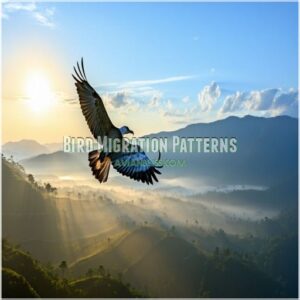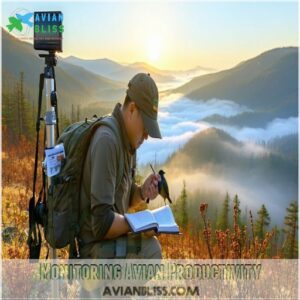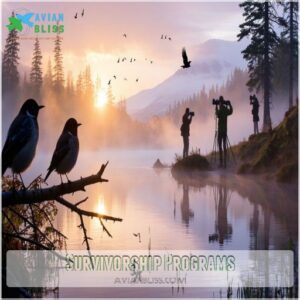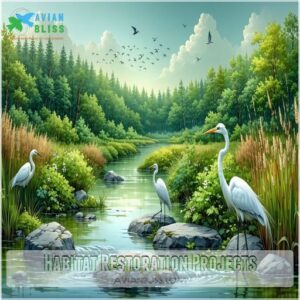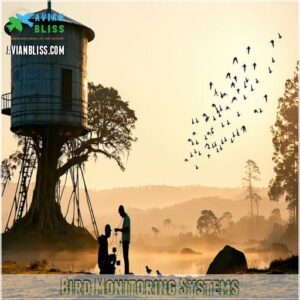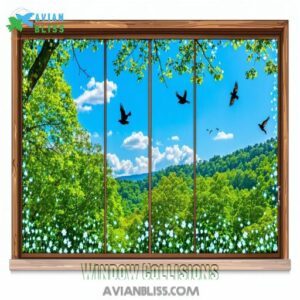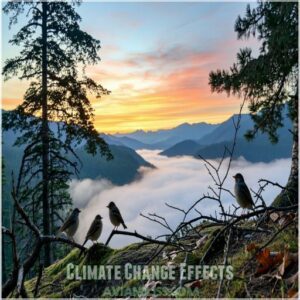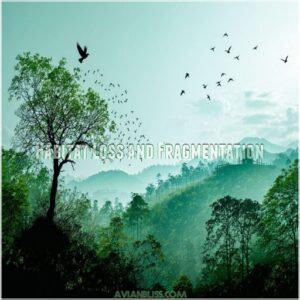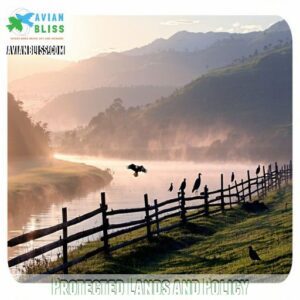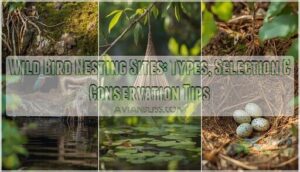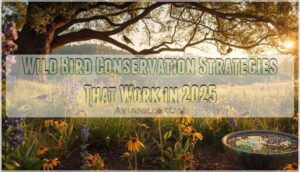This site is supported by our readers. We may earn a commission, at no cost to you, if you purchase through links.
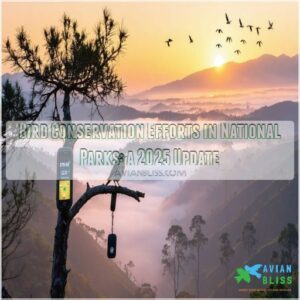
These parks serve as essential sanctuaries, protecting over 350 migratory species and their habitats.
Programs like the Park Flight Migratory Bird Program team up with international partners to map flight patterns and restore critical regions, from the Mississippi wetlands to the Sonoran Desert.
They’re even tackling threats like habitat loss, climate change, and bird collisions—all with science-backed strategies.
By monitoring bird productivity and using tracking tools like the Motus system, they guarantee species thrive.
Stick around, and you just might uncover how these efforts safeguard ecosystems—and maybe a feathered friend near you!
Table Of Contents
- Key Takeaways
- Bird Migration Patterns
- Conservation Efforts
- Bird Monitoring Systems
- Threats to Bird Populations
- Protected Lands and Policy
- Frequently Asked Questions (FAQs)
- How do scientists monitor bird populations in parks?
- Why are birds a good indicator of ecosystem conditions?
- Why should you participate in the Great Backyard Bird Count?
- What can we do to protect our national parks?
- What do national parks do for conservation?
- What is the US Wild bird conservation Act?
- Who is a famous bird conservationist?
- What did the Migratory Bird Conservation Act do?
- How do governments protect birds?
- What is the #1 threat to birds in America?
- Conclusion
Key Takeaways
- National parks protect over 350 migratory bird species by restoring habitats, tackling climate change, and using science-backed strategies like the Motus Wildlife Tracking System.
- Programs like the Park Flight Migratory Bird Program and international collaborations ensure safe migratory routes and connect conservation efforts beyond borders.
- Advanced monitoring systems like GPS trackers and MAPS stations collect critical data to protect species and guide targeted conservation actions.
- National parks fight bird collisions with bird-friendly designs, UV-reflective materials, and habitat restoration, addressing threats that kill millions of birds annually.
Bird Migration Patterns
You’ve probably seen birds flocking south in winter, but their journeys are far more complex than they seem.
National parks play a key role in studying these migration patterns, partnering with international programs to protect essential stopover sites.
North American Bird Species
Migratory birds bring life to North America’s skies, showcasing incredible species diversity.
Each year, over 350 species traverse vast migration routes, relying on essential bird habitats for survival.
The National Park Service leads avian research to track birds and support wildlife conservation.
Here’s why bird conservation matters:
- Supports ecosystems
- Tracks conservation status
- Improves national park management
- Protects species diversity
- Enhances wildlife observation
International Collaboration
Birds don’t care about borders, so why should we?
Global partnerships like those by the National Park Service and transnational programs unite experts in conservation biology.
They tackle shared challenges like habitat loss and climate change.
Here’s how international cooperation strengthens bird conservation:
| Example | |
|---|---|
| Cross-border teams | Habitat restoration |
Park Flight Migratory Bird Program
The Park Flight Migratory Bird Program connected national parks with international teams to protect migratory birds.
By sharing species research and mapping flight patterns, it highlighted critical spots along migratory routes.
The program fostered international collaborations, as detailed in the Park Flight legacy report.
These bird conservation efforts didn’t just protect habitats—they built partnerships across borders.
Whether restoring habitats or tracking migratory birds, it proved that teamwork can save feathers and ecosystems alike.
Conservation Efforts
You’ll find that national parks play a pivotal role in protecting bird populations through focused conservation efforts.
From tracking survival rates to restoring habitats, these programs use science-backed strategies to safeguard species and their ecosystems.
Monitoring Avian Productivity
Tracking bird demographics through the MAPS program lets you see the bigger picture of avian health and nesting success.
National parks collect data like fledgling rates and breeding patterns to fine-tune bird conservation efforts.
With over 120 bird monitoring stations, this program guarantees bird populations thrive, offering key insights to protect habitats and keep feathered friends soaring high, which is crucial for the conservation efforts.
Survivorship Programs
You’d be amazed at how survivorship programs spotlight bird demographics and avian research.
Through MAPS, bird conservation programs track migration patterns and species survival by studying bird reproduction, age, and health.
These efforts drive smarter conservation strategies.
The U.S. Fish and Wildlife Service details top bird threats, including collisions with buildings, towers, power lines, and vehicles.
By knowing what’s threatening bird populations, scientists adjust bird management to protect survival and long-term stability, which leads to real, impactful change and informed bird management.
Data powers this process.
Habitat Restoration Projects
Imagine a meadow bursting with life—habitat restoration makes that happen.
Wetland recovery boosts water filtration, forest regeneration nurtures nesting birds, and grassland renewal protects rare species.
You can further support these efforts through bird habitat restoration products.
Wildlife corridors connect ecosystems, ensuring survival, and these projects improve ecosystem services like clean air and water.
Park conservation efforts show how ecosystem management and habitat conservation power wildlife preservation for generations to come.
Bird Monitoring Systems
You’ll find that advanced bird monitoring systems are transforming how national parks track and protect bird populations.
From high-tech electronic tags to massive tracking networks like Motus, these tools provide precise data to guide conservation efforts.
Inventory and Monitoring Networks
Think of Inventory and Monitoring networks as the National Park Service’s “detectives” for bird conservation.
These networks track changes in bird populations, offering essential data collection for ecosystem health and guiding conservation strategies.
Birds act as important ecosystem health indicators, providing insights into overall environmental well-being.
By linking parks across the U.S., they inform wildlife management and habitat conservation with precision, giving birds a voice in their natural storylines, which is crucial for ecosystem health.
Electronic Tracking Devices
Looking to track that elusive warbler? Electronic tracking devices are revolutionizing bird research. Today’s wildlife monitoring tech fits birds like a custom suit, from tiny PIT tags to sophisticated GPS tracking systems.
Here’s what’s making waves in bird sensors:
- Light-level geolocators map migration routes
- Platform transmitter terminals track long-distance flights
- GPS devices monitor local movements
- Radio telemetry provides real-time location data
Device innovation keeps shrinking sizes while boosting battery life, making bird tracking more effective than ever. Researchers rely on bird tracking devices to study bird behavior and habitats in greater detail.
Motus Wildlife Tracking System
While electronic tracking reveals broad migration patterns, the Motus Wildlife Tracking System takes a more precise approach.
Fort Union National Monument made history in 2022 by installing the first National Park Service radio telemetry station for this innovative wildlife tracking network.
You’ll find these automated receivers collecting detailed data about animal movement patterns, helping conservation technology advance bird conservation efforts across national parks.
Threats to Bird Populations
You’ll be surprised to learn that North American bird populations have declined by 30% in the last 50 years, with window collisions alone causing one billion bird deaths annually in the U.S.
While you’re exploring our national parks, you’ll notice new initiatives like UV-reflective window stickers and habitat restoration projects that are helping to protect our feathered friends from these mounting challenges.
Window Collisions
While monitoring systems track bird populations, a silent threat looms in plain sight.
Window strikes claim one billion birds annually in the U.S., with nearly half occurring on buildings under four stories.
Here’s what national parks are doing about bird-window collisions:
- Zion applies UV-reflective stickers, reducing strikes by 78%
- Petrified Forest uses soapy window treatments
- Liberty’s museum features bird-friendly glass designs
- Historic buildings get specialized collision prevention
- Visitor centers implement window safety measures to prevent window strikes
Climate Change Effects
While window protection strategies help, a NASA study reveals climate change poses broader challenges for our feathered friends.
Temperature shifts affect migration timing, triggered by weather patterns thousands of miles away.
Here’s how climate change impacts bird populations:
| Climate Factor | Effect | Conservation Response |
|---|---|---|
| Temperature Shift | Altered Migration Timing | Enhanced Monitoring |
| Sea Level Rise | Coastal Habitat Loss | Marsh Restoration |
| Weather Pattern Changes | Resource Mismatch | Climate-adaptive Planning |
| Ecosystem Disruption | Hormonal Changes | Protected Area Networks |
Habitat Loss and Fragmentation
North American wildlife faces a stark reality as fragmented landscapes chip away at essential habitat loss and fragmentation.
Recent studies show a devastating 73% decline in monitored wildlife populations over just 50 years, with deforestation impacts and urban sprawl leading the assault.
You’ll find these ecosystem degradation effects particularly evident in our national parks.
The climate change effects on bird populations are a significant concern, as they exacerbate habitat loss and fragmentation.
- One in four birds has vanished from North America since 1970
- Urban regions lost 25% of habitats to fragmentation in the past century
- Wildlife corridors remain critical for maintaining ecosystem connectivity
- Habitat protection efforts focus on preserving remaining natural spaces
- Food systems drive the most significant habitat degradation worldwide
Protected Lands and Policy
You’ll find over 300 million acres of protected public land across America’s national parks and territories, providing essential habitats for countless bird species.
You can help preserve these vital ecosystems by supporting initiatives like the Wildlife Movement Through Partnerships Act, which enhances park landscapes and strengthens bird conservation efforts.
Public Land Management
Today’s public land management faces unique challenges across 415 million acres of diverse terrain.
You’ll find complex decisions balancing ecosystem services with resource allocation in national parks, where wildlife corridors often cross park boundaries.
Land use planning has evolved to integrate habitat protection strategies, while conservation efforts focus on connecting fragmented landscapes.
Public lands now serve as essential sanctuaries for preserving America’s natural heritage.
National Conservation Initiatives
Conservation strategies received a major boost with the signing of the America’s Conservation Enhancement Reauthorization Act in December 2024.
This strengthens wildlife protection across national parks and beyond.
The NABCI coalition continues leading ecosystem management efforts through integrated partnerships.
You’ll see the impact of these conservation efforts in three key ways:
- Every protected bird species represents hope for future generations
- Your local national park’s biodiversity drives wider environmental protection
- Each conservation success story shows we’re making real progress together
Effective bird conservation methods are essential for preserving ecosystems.
Bird-Friendly Building Design
Following the 2024 Multi-Sector Summit, national parks have revolutionized their approach to eco architecture.
The Statue of Liberty Museum leads by example with its bird-friendly glass design, while new guidelines require 100% bird-safe materials within 100 feet above grade.
The implementation of Bird Friendly materials is essential for reducing bird collisions.
| Design Feature | Impact & Implementation |
|---|---|
| Fritted Glass | Cost-effective, reduces collisions 78% |
| UV Materials | Tested in controlled environments |
| Reduced Glass | Cuts facade glass from 70% to 35% |
| Green Features | Promotes occupant wellbeing |
Frequently Asked Questions (FAQs)
How do scientists monitor bird populations in parks?
You’ll find scientists using tools like banding, audio recordings, and GPS trackers to monitor bird populations.
They collect data on age, health, and migration routes, uncovering critical insights to guide conservation efforts and protect habitats.
Why are birds a good indicator of ecosystem conditions?
You can count on birds to tell you how an ecosystem’s doing because they’re sensitive to changes like habitat loss or pollution.
When bird populations thrive or decline, it’s often a reflection of the environment’s health.
Why should you participate in the Great Backyard Bird Count?
Every little bit helps, and counting birds in your backyard is like giving nature a quick health check.
You’ll connect with wildlife, contribute to global science, and maybe even spot a feathered celebrity!
What can we do to protect our national parks?
Pitch in by leaving no trace when hiking, supporting conservation initiatives, and donating to park programs.
Choose eco-friendly products and advocate for laws protecting wildlife, as small actions ripple into big changes for preserving these spaces, particularly through conservation initiatives.
What do national parks do for conservation?
Protecting wildlife, restoring habitats, and monitoring species, national parks act like nature’s guardians.
They guarantee ecosystems thrive, tackle threats like climate change, and give you spaces to reconnect with nature.
They also support research and education, which is crucial for the preservation of these areas, while allowing you to experience the beauty of nature.
What is the US Wild bird conservation Act?
The U.S. Wild Bird Conservation Act protects endangered bird species by regulating their importation.
It guarantees sustainable trade, promotes conservation in their native habitats, and prevents illegal exploitation.
It preserves bird populations for future generations.
Who is a famous bird conservationist?
John James Audubon’s name might ring a bell—he painted and studied birds passionately, inspiring conservation movements.
Jane Goodall also champions avian conservation through her work connecting wildlife, habitats, and communities globally.
What did the Migratory Bird Conservation Act do?
Picture a safety net spanning skies and borders.
The Migratory Bird Conservation Act of 1929 secured essential habitats for migratory birds by funding wetland conservation, restoring ecosystems, and ensuring healthier environments for birds and humans alike.
How do governments protect birds?
Governments protect birds by creating wildlife reserves, enacting laws like the Migratory Bird Treaty Act, and collaborating internationally.
They fund conservation programs, restore habitats, monitor populations, and push for policies tackling climate change and habitat destruction.
What is the #1 threat to birds in America?
Sky-high skyscrapers and shiny surfaces spell doom for birds—glass collisions kill a billion annually in the U.S.
They misread reflections as open skies, making windows their #1 silent, accidental predator.
Conclusion
Every feather in the flock counts, and national parks prove it with their bird conservation efforts.
By protecting habitats, tracking migration with cutting-edge tools like the Motus system, and tackling threats like habitat loss and climate change head-on, these parks guarantee birds thrive for generations.
They collaborate internationally and spearhead projects like the Park Flight Migratory Bird Program.
Your local park isn’t just scenic—it’s a frontline for conservation.
So, keep exploring and supporting efforts that safeguard our winged neighbors!
- https://en.wikipedia.org/wiki/Bird_conservation
- https://nabci-us.org/the-legacy-of-park-flight-the-value-of-international-engagement-for-birds-and-people/
- https://www.jwa.or.jp/english/service/bird-monitoring-system/
- https://www.scienceofbirds.com/blog/top-5-global-threats-to-bird-populations
- https://www.doi.gov/news/pressreleases/doi-and-usda-highlight-successes-of-protecting-bird-habitat-on-private-lands

